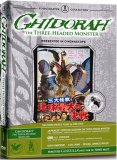There’s a heat-wave in January, and dozens of meteorites are falling from the sky. The plane carrying a princess explodes, but the princess has somehow survived, though she has no memory of her former self and believes herself to be Venusian, come to warn humanity of impending calamity. In due course, this calamity arrives as one of the meteorites transforms into King Ghidorah. Earth will be destroyed unless Mothra manages to convince Godzilla and Rodan to stop fighting each other and instead take on King Ghidorah.
This follow-up to Mothra vs Godzilla marks the point at which the series definitively took a deliberate turn for the comic, for good or ill. The slapstick had already been present in King Kong vs Godzilla, but now it would be here to stay. The storylines would also become more and more outlandish. The monster battles here are largely in the countryside, thus cutting costs on the expensive destruction of city miniatures. Whatever one’s feelings on the direction the series took from this point on until the late 70’s, the wrasslin’ is still a lot of fun, both exciting and funny. However, it is far too long in coming. The monsters have far too little screen time, taking backseat to the rather uninteresting (but much cheaper to film) human stories.
Audio
The point of these releases is to finally present the films in their original form, and so the tracks, both the Japanese and the dubbed English, are mono. The sound is plenty warm all the same, with no static or distortion. There are limits to what one can say about mono, but what there is to say about this track is all good.
Video
Both the American and original Japanese cuts of the film are presented here. The colours in both cases are very nice, with strong contrasts and fine blacks, but the Japanese print is in better shape. This isn’t to say it’s perfect: there is speckling and other bits of minor damage visible throughout, but these problems aren’t severe, and the this version is noticeably sharper than the American take.
Special Features
David Kalat’s commentary is a lively one as he not only mounts a spirited defense of the film’s comic tone but also makes the case for preferring the US cut over the Japanese one (certainly the former, running some 8 minutes shorter, moves along at a faster clip). The series of fine biographical featurettes continues with a look at FX wizard Eiji Tsuburaya. The image and poster galleries are both fully annotated, which is nice, and the original Japanese trailer rounds things off.
Closing Thoughts
I would argue that, by this point, the series best days were behind it, until the 80’s revival, but the films are still fun, and it sure is nice to see them in their proper format for the first time.



